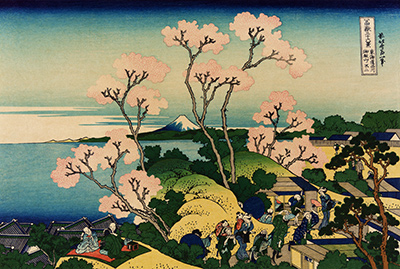Goten-yama-hill Shinagawa on the Tokaido also referred to as Fuji from Gotenyama at Shinagawa on the Tōkaidō or Tōkaidō Shinagawa Gotenyama no Fuji, is an amazing masterpiece from Katsushika Hokusai’s series Thirty-six Views of Mount Fuji also called Fugaku sanjūrokkei.
Hokusai was born in 1670 in Edo district and died in 1849 and was buried in Seikyō-ji in Tokyo (Taito Ward). The print Goten-yama-hill Shinagawa on the Tokaido was produced in ca. 1830-32 during the Edo period of between 1615 and 1868. It was printed on a Polychrome woodblock print; ink and color on paper with dimensions of H. 9 1/2 in. (24.1 cm); W. 14 1/8 in. (35.9 cm) and classified as a print.
Goten-yama-hill at Shinagawa was known for its beautiful cherry blossoms during the famous Edo period. Hokusai did just one print about the cherry blossom in Thirty-Six Views of Mount Fuji. But an equally talented artist who printed several pieces of work about it is Utagawa Hiroshige. The people who take part in the viewing of the pale pink of the blossoms are the draw the attention of the fact that the Goten-yama-hill at Shinagawa was exceptionally beautiful.
They also seem to be enjoying the beautiful sightseeing of the Mount Fuji. But the three-men on the left-side of the Goten-yama-hill at Shinagawa on the Tokaido print seem to be enjoying their drinking and eating. Originally born Tokitara, Hokusai learned a few painting skills from his father who was a mirror-maker. His father used to paint some of the frames of his mirrors and Hokusai borrowed a leaf at an early age of four-years-old. Katsushika Hokusai had thirty other pseudonyms that represented various periods and styles of painting.
The surname Hokusai, however, prevailed upon the other Monikers throughout his entire career. His most iconic artwork is the Thirty-six Views of Mount Fuji which was a combination of various paintings representing the relationship between humans and the environment. Hokusai collaborated with other artists such as Takizawa Bakin in 1807 in a series of doing illustrated books. However, the relationship the between the two didn’t last long due to artistic differences and the publisher who saw the significance of painting in illustrated works of the time decided to keep Hokusai, and thus let Bakin leave. When disaster struck Hokusai’s studio in 1839 razing down most of his pieces of artwork, some new crop of artists like Andō Hiroshige took over and became very popular. However, he still managed to complete the Ducks in a Stream project before he died in 1849.




